Abstract
Aging is the progressive accumulation of changes with time that are associated with or responsible for the ever-increasing susceptibility to disease and death which accompanies advancing age. These time-related changes are attributed to the aging process. The nature of the aging process has been the subject of considerable speculation. Accumulating evidence now indicates that the sum of the deleterious free radical reactions going on continuously throughout the cells and tissues constitutes the aging process or is a major contributor to it. In mammalian systems the free radical reactions are largely those involving oxygen. Dietary manipulations expected to lower the rate of production of free radical reaction damage have been shown (i) to increase the life span of mice, rats, fruit flies, nematodes, and rotifers, as well as the "life span" of neurospora; (ii) to inhibit development of some forms of cancer; (iii) to enhance humoral and cell-mediated immune responses; and (iv) to slow development of amyloidosis and the autoimmune disorders of NZB and NZB/NZW mice. In addition, studies strongly suggest that free radical reactions play a significant role in the deterioration of the cardiovascular and central nervous systems with age. The free radical theory of aging provides reasonable explanations for age-associated phenomena, including (i) the relationship of the average life spans of mammalian species to their basal metabolic rates, (ii) the clustering of degenerative diseases in the terminal part of the life span, (iii) the beneficial effect of food restriction on life span, (iv) the greater longevity of females, and (v) the increase in autoimmune manifestations with age. It is not unreasonable to expect on the basis of present data that the healthy life span can be increased by 5-10 or more years by keeping body weight down, at a level compatible with a sense of well-being, while ingesting diets adequate in essential nutrients but designed to minimize random free radical reactions in the body.
Full text
PDF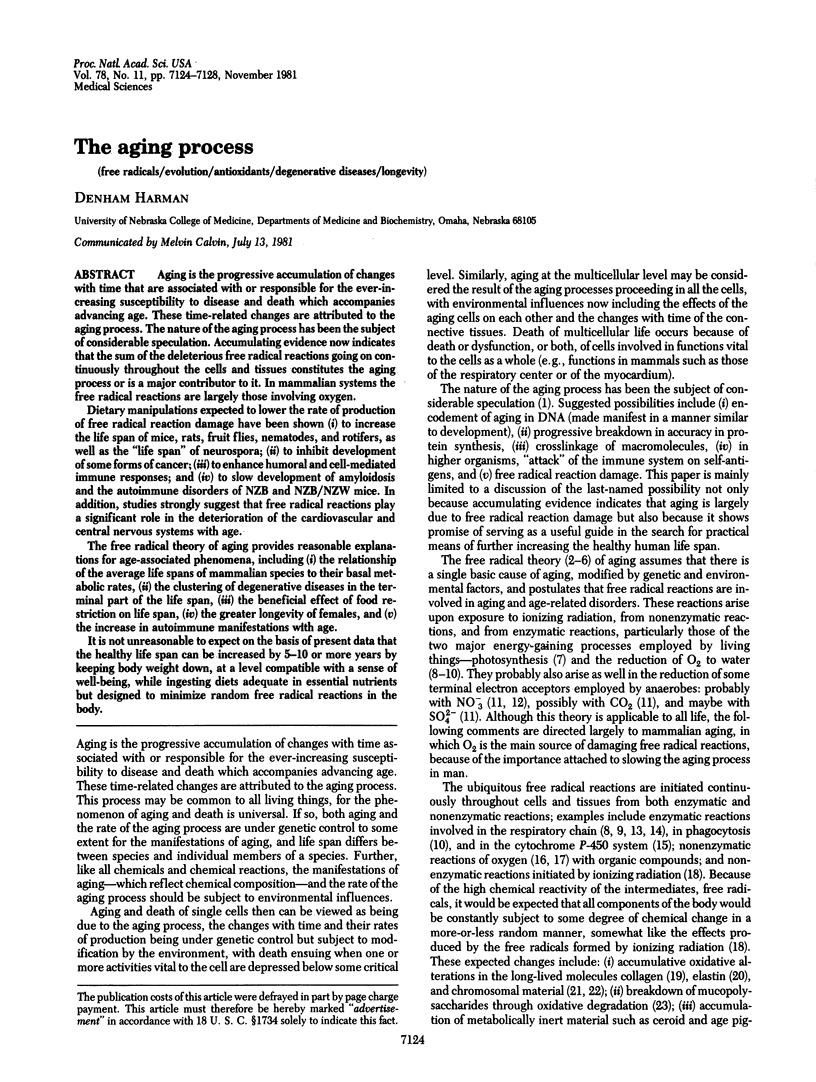
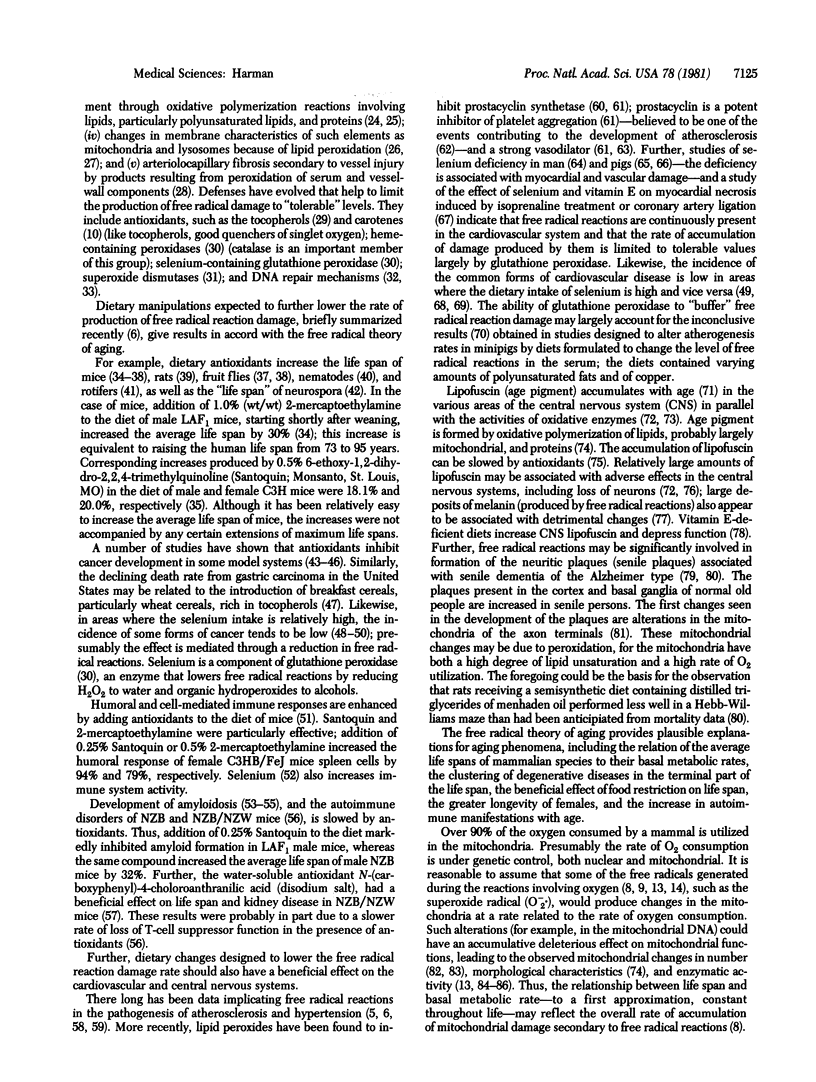
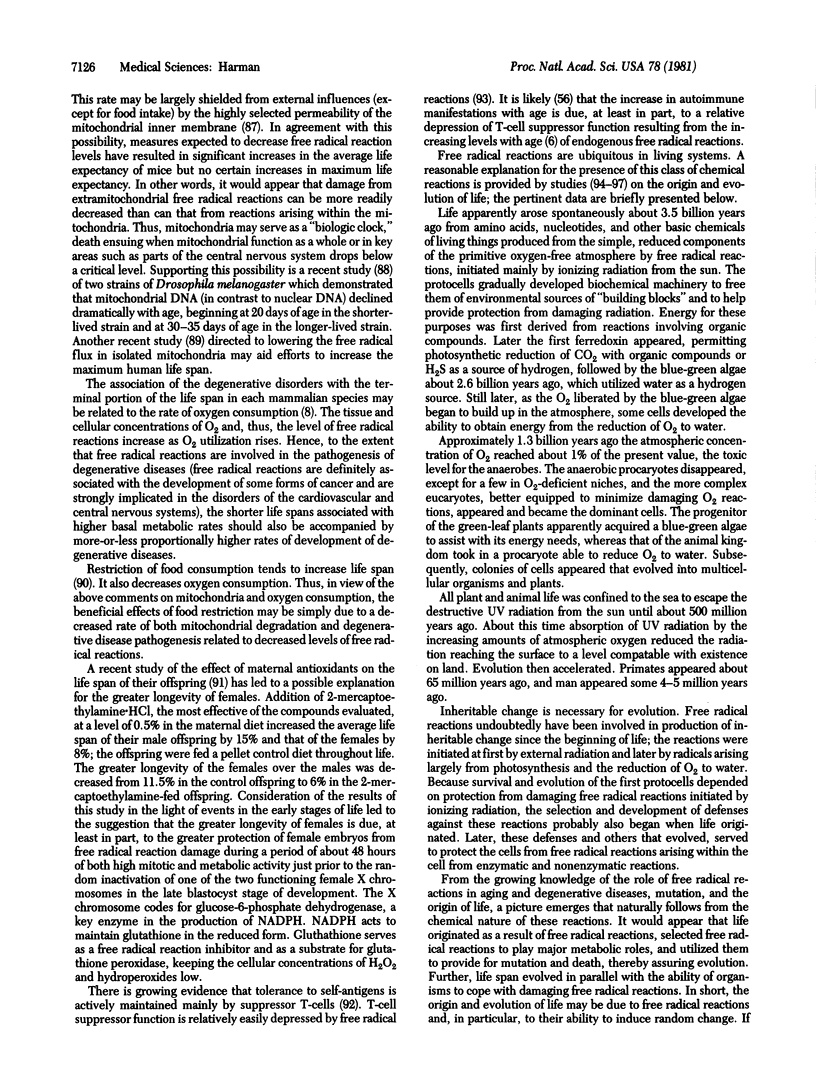
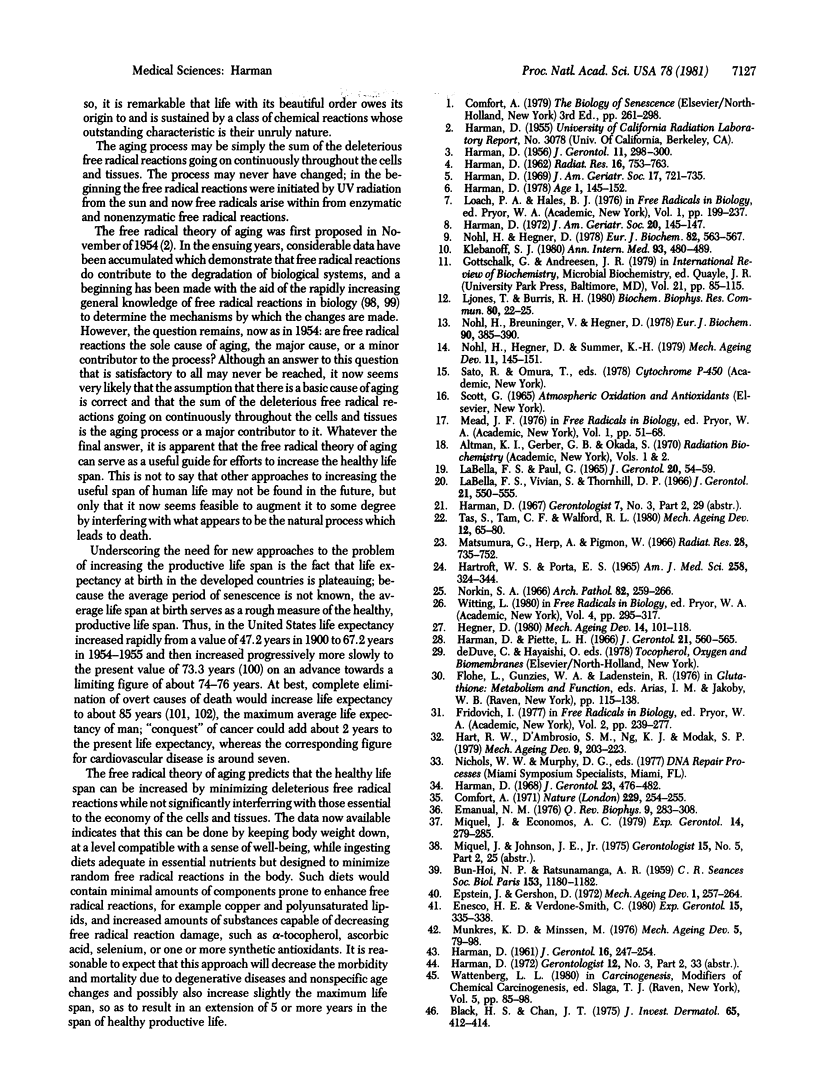
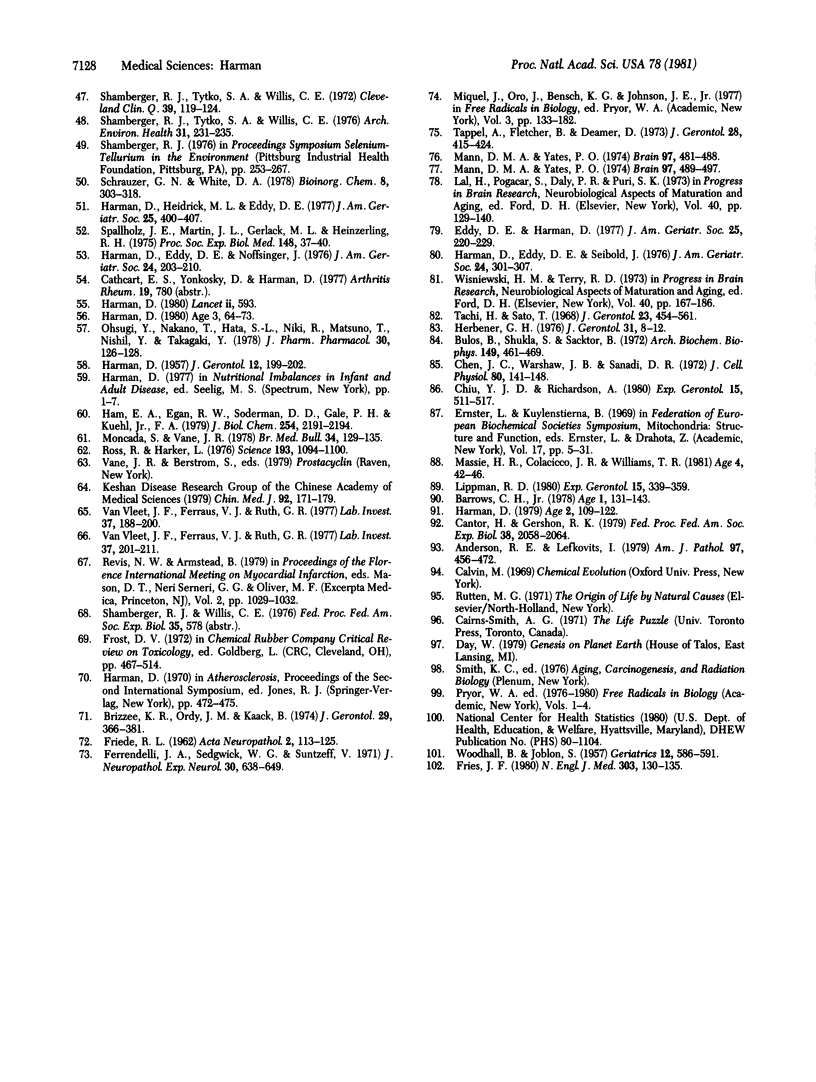
Selected References
These references are in PubMed. This may not be the complete list of references from this article.
- Anderson R. E., Lefkovits I. In vitro evaluation of radiation-induced augmentation of the immune response. Am J Pathol. 1979 Dec;97(3):456–472. [PMC free article] [PubMed] [Google Scholar]
- BUU-HOI N. P., RATSIMAMANGA A. R. [Retarding action of nordihydroguiaiaretic acid on aging in the rat]. C R Seances Soc Biol Fil. 1959;153:1180–1182. [PubMed] [Google Scholar]
- Black H. S., Chan J. T. Suppression of ultraviolet light-induced tumor formation by dietary antioxidants. J Invest Dermatol. 1975 Oct;65(4):412–414. doi: 10.1111/1523-1747.ep12607661. [DOI] [PubMed] [Google Scholar]
- Brizzee K. R., Ordy J. M., Kaack B. Early appearance and regional differences in intraneuronal and extraneuronal lipofuscin accumulation with age in the brain of a nonhuman primate (Macaca mulatta). J Gerontol. 1974 Jul;29(4):366–381. doi: 10.1093/geronj/29.4.366. [DOI] [PubMed] [Google Scholar]
- Bulos B., Shukla S., Sacktor B. Bioenergetic properties of mitochondria from flight muscle of aging blowflies. Arch Biochem Biophys. 1972 Apr;149(2):461–469. doi: 10.1016/0003-9861(72)90345-1. [DOI] [PubMed] [Google Scholar]
- Cantor H., Gershon R. K. Immunological circuits: cellular composition. Fed Proc. 1979 Jun;38(7):2058–2064. [PubMed] [Google Scholar]
- Chen J. C., Warshaw J. B., Sanadi D. R. Regulation of mitochondrial respiration in senescence. J Cell Physiol. 1972 Aug;80(1):141–148. doi: 10.1002/jcp.1040800115. [DOI] [PubMed] [Google Scholar]
- Chiu Y. J., Richardson A. Effect of age on the function of mitochondria isolated from brain and heart tissue. Exp Gerontol. 1980;15(6):511–517. doi: 10.1016/0531-5565(80)90003-0. [DOI] [PubMed] [Google Scholar]
- Comfort A., Youhotsky-Gore I., Pathmanathan K. Effect of ethoxyquin on the longevity of C3H mice. Nature. 1971 Jan 22;229(5282):254–255. doi: 10.1038/229254a0. [DOI] [PubMed] [Google Scholar]
- Eddy D. E., Harman D. Free radical theory of aging: effect of age, sex and dietary precursors on rat-brain docosahexanoic acid. J Am Geriatr Soc. 1977 May;25(5):220–229. doi: 10.1111/j.1532-5415.1977.tb00303.x. [DOI] [PubMed] [Google Scholar]
- Emanuel N. M. Free radicals and the action of inhibitors of radical processes under pathological states and ageing in living organisms and in man. Q Rev Biophys. 1976 May;9(2):283–308. doi: 10.1017/s0033583500002420. [DOI] [PubMed] [Google Scholar]
- Enesco H. E., Verdone-Smith C. alpha-Tocopherol increases lifespan in the rotifer Philodina. Exp Gerontol. 1980;15(5):335–338. doi: 10.1016/0531-5565(80)90039-x. [DOI] [PubMed] [Google Scholar]
- Ferrendelli J. A., Sedgwick W. G., Suntzeff V. Regional energy metabolism and lipofuscin accumulation in mouse brain during aging. J Neuropathol Exp Neurol. 1971 Oct;30(4):638–649. doi: 10.1097/00005072-197110000-00008. [DOI] [PubMed] [Google Scholar]
- Fries J. F. Aging, natural death, and the compression of morbidity. N Engl J Med. 1980 Jul 17;303(3):130–135. doi: 10.1056/NEJM198007173030304. [DOI] [PubMed] [Google Scholar]
- HARMAN D. Aging: a theory based on free radical and radiation chemistry. J Gerontol. 1956 Jul;11(3):298–300. doi: 10.1093/geronj/11.3.298. [DOI] [PubMed] [Google Scholar]
- HARMAN D. Atherosclerosis: a hypothesis concerning the initiating steps in pathogenesis. J Gerontol. 1957 Apr;12(2):199–202. doi: 10.1093/geronj/12.2.199. [DOI] [PubMed] [Google Scholar]
- HARMAN D. Prolongation of the normal lifespan and inhibition of spontaneous cancer by antioxidants. J Gerontol. 1961 Jul;16:247–254. doi: 10.1093/geronj/16.3.247. [DOI] [PubMed] [Google Scholar]
- HARMAN D. Role of free radicals in mutation, cancer, aging, and the maintenance of life. Radiat Res. 1962 May;16:753–763. [PubMed] [Google Scholar]
- Ham E. A., Egan R. W., Soderman D. D., Gale P. H., Kuehl F. A., Jr Peroxidase-dependent deactivation of prostacyclin synthetase. J Biol Chem. 1979 Apr 10;254(7):2191–2194. [PubMed] [Google Scholar]
- Harman D., Eddy D. E., Noffsinger J. Free radical theory of aging: inhibition of amyloidosis in mice by antioxidants; possible mechanism. J Am Geriatr Soc. 1976 May;24(5):203–210. doi: 10.1111/j.1532-5415.1976.tb06780.x. [DOI] [PubMed] [Google Scholar]
- Harman D. Free radical theory of aging: effect of free radical reaction inhibitors on the mortality rate of male LAF mice. J Gerontol. 1968 Oct;23(4):476–482. doi: 10.1093/geronj/23.4.476. [DOI] [PubMed] [Google Scholar]
- Harman D., Heidrick M. L., Eddy D. E. Free radical theory of aging: effect of free-radical-reaction inhibitors on the immune response. J Am Geriatr Soc. 1977 Sep;25(9):400–407. doi: 10.1111/j.1532-5415.1977.tb00674.x. [DOI] [PubMed] [Google Scholar]
- Harman D., Hendricks S., Eddy D. E., Seibold J. Free radical theory of aging: effect of dietary fat on central nervous system function. J Am Geriatr Soc. 1976 Jul;24(7):301–307. doi: 10.1111/j.1532-5415.1976.tb06800.x. [DOI] [PubMed] [Google Scholar]
- Harman D., Piette L. H. Free radical theory of aging: free radical reactions in serum. J Gerontol. 1966 Oct;21(4):560–565. doi: 10.1093/geronj/21.4.560. [DOI] [PubMed] [Google Scholar]
- Harman D. Prolongation of life: role of free radical reactions in aging. J Am Geriatr Soc. 1969 Aug;17(8):721–735. doi: 10.1111/j.1532-5415.1969.tb02286.x. [DOI] [PubMed] [Google Scholar]
- Harman D. Secondary amyloidosis and antioxidants. Lancet. 1980 Sep 13;2(8194):593–593. doi: 10.1016/s0140-6736(80)92028-0. [DOI] [PubMed] [Google Scholar]
- Harman D. The biologic clock: the mitochondria? J Am Geriatr Soc. 1972 Apr;20(4):145–147. doi: 10.1111/j.1532-5415.1972.tb00787.x. [DOI] [PubMed] [Google Scholar]
- Hart R. W., D'Ambrosio S. M., Ng K. J., Modak S. P. Longevity, stability and DNA repair. Mech Ageing Dev. 1979 Feb;9(3-4):203–223. doi: 10.1016/0047-6374(79)90100-3. [DOI] [PubMed] [Google Scholar]
- Hartroft W. S., Porta E. A. Ceroid. Am J Med Sci. 1965 Sep;250(3):324–345. [PubMed] [Google Scholar]
- Hegner D. Age-dependence of molecular and functional changes in biological membrane properties. Mech Ageing Dev. 1980 Sep-Oct;14(1-2):101–118. doi: 10.1016/0047-6374(80)90109-8. [DOI] [PubMed] [Google Scholar]
- Herbener G. H. A morphometric study of age-dependent changes in mitochondrial population of mouse liver and heart. J Gerontol. 1976 Jan;31(1):8–12. doi: 10.1093/geronj/31.1.8. [DOI] [PubMed] [Google Scholar]
- Klebanoff S. J. Oxygen metabolism and the toxic properties of phagocytes. Ann Intern Med. 1980 Sep;93(3):480–489. doi: 10.7326/0003-4819-93-3-480. [DOI] [PubMed] [Google Scholar]
- LABELLA F. S. STRUCTURE OF COLLAGEN FROM HUMAN TENDON AS INFLUENCED BY AGE AND SEX. J Gerontol. 1965 Jan;20:54–59. doi: 10.1093/geronj/20.1.54. [DOI] [PubMed] [Google Scholar]
- LaBella F. S., Vivian S., Thornhill D. P. Amino acid composition of human aortic elastin as influenced by age. J Gerontol. 1966 Oct;21(4):550–555. doi: 10.1093/geronj/21.4.550. [DOI] [PubMed] [Google Scholar]
- Lippman R. D. Chemiluminescent measurement of free radicals and antioxidant molecular-protection inside living rat-mitochondria. Exp Gerontol. 1980;15(5):339–351. doi: 10.1016/0531-5565(80)90040-6. [DOI] [PubMed] [Google Scholar]
- Ljones T., Burris R. H. Evidence for one-electron transfer by the Fe protein of nitrogenase. Biochem Biophys Res Commun. 1978 Jan 13;80(1):22–25. doi: 10.1016/0006-291x(78)91098-7. [DOI] [PubMed] [Google Scholar]
- Mann D. M., Yates P. O. Lipoprotein pigments--their relationship to ageing in the human nervous system. I. The lipofuscin content of nerve cells. Brain. 1974 Sep;97(3):481–488. doi: 10.1093/brain/97.1.481. [DOI] [PubMed] [Google Scholar]
- Mann D. M., Yates P. O. Lipoprotein pigments--their relationship to ageing in the human nervous system. II. The melanin content of pigmented nerve cells. Brain. 1974 Sep;97(3):489–498. doi: 10.1093/brain/97.1.489. [DOI] [PubMed] [Google Scholar]
- Matsumura G., Herp A., Pigman W. Depolymerization of hyaluronic acid by autoxidants and radiatiions. Radiat Res. 1966 Aug;28(4):735–752. [PubMed] [Google Scholar]
- Miquel J., Economos A. C. Favorable effects of the antioxidants sodium and magnesium thiazolidine carboxylate on the vitality and life span of Drosophila and mice. Exp Gerontol. 1979;14(5):279–285. doi: 10.1016/0531-5565(79)90039-1. [DOI] [PubMed] [Google Scholar]
- Moncada S., Vane J. R. Unstable metabolites of arachidonic acid and their role in haemostasis and thrombosis. Br Med Bull. 1978 May;34(2):129–135. doi: 10.1093/oxfordjournals.bmb.a071482. [DOI] [PubMed] [Google Scholar]
- Munkres K. D., Minssen M. Ageing of Neurospora crassa. I. Evidence for the free radical theory of ageing from studies of a natural-death mutant. Mech Ageing Dev. 1976 Mar-Apr;5(2):79–98. doi: 10.1016/0047-6374(76)90010-5. [DOI] [PubMed] [Google Scholar]
- Nohl H., Breuninger V., Hegner D. Influence of mitochondrial radical formation on energy-linked respiration. Eur J Biochem. 1978 Oct;90(2):385–390. doi: 10.1111/j.1432-1033.1978.tb12615.x. [DOI] [PubMed] [Google Scholar]
- Nohl H., Hegner D. Do mitochondria produce oxygen radicals in vivo? Eur J Biochem. 1978 Jan 16;82(2):563–567. doi: 10.1111/j.1432-1033.1978.tb12051.x. [DOI] [PubMed] [Google Scholar]
- Nohl H., Hegner D., Summer K. H. Responses of mitochondrial superoxide dismutase, catalase and glutathione peroxidase activities to aging. Mech Ageing Dev. 1979 Oct;11(3):145–151. doi: 10.1016/0047-6374(79)90050-2. [DOI] [PubMed] [Google Scholar]
- Norkin S. A. Lipid nature of ceroid in experimental nutritional cirrhosis. Arch Pathol. 1966 Sep;82(3):259–266. [PubMed] [Google Scholar]
- Ohsugi Y., Nakano T., Hata S. I., Niki R., Matsuno T., Nishii Y., Takagaki Y. N-(2-Carboxyphenyl)-4-chloroanthranilic acid disodium salt: prevention of autoimmune kidney disease in NZB/NZW F1 hybird mice. J Pharm Pharmacol. 1978 Feb;30(2):126–128. doi: 10.1111/j.2042-7158.1978.tb13180.x. [DOI] [PubMed] [Google Scholar]
- Ross R., Harker L. Hyperlipidemia and atherosclerosis. Science. 1976 Sep 17;193(4258):1094–1100. doi: 10.1126/science.822515. [DOI] [PubMed] [Google Scholar]
- Schrauzer G. N., White D. A. Selenium in human nutrition: dietary intakes and effects of supplementation. Bioinorg Chem. 1978 Apr;8(4):303–318. doi: 10.1016/s0006-3061(00)80164-7. [DOI] [PubMed] [Google Scholar]
- Shamberger R. J., Tytko S. A., Willis C. E. Antioxidants and cancer. Part VI. Selenium and age-adjusted human cancer mortality. Arch Environ Health. 1976 Sep-Oct;31(5):231–235. doi: 10.1080/00039896.1976.10667225. [DOI] [PubMed] [Google Scholar]
- Shamberger R. J., Tytko S., Willis C. E. Antioxidants in cereals and in food preservatives and declining gastric cancer mortality. Cleve Clin Q. 1972 Fall;39(3):119–124. doi: 10.3949/ccjm.39.3.119. [DOI] [PubMed] [Google Scholar]
- Spallholz J. E., Martin J. L., Gerlach M. L., Heinzerling R. H. Injectable selenium: effect on the primary response of mice (38472). Proc Soc Exp Biol Med. 1975 Jan;148(1):37–40. doi: 10.3181/00379727-148-38472. [DOI] [PubMed] [Google Scholar]
- Tappel A., Fletcher B., Deamer D. Effect of antioxidants and nutrients on lipid peroxidation fluorescent products and aging parameters in the mouse. J Gerontol. 1973 Oct;28(4):415–424. doi: 10.1093/geronj/28.4.415. [DOI] [PubMed] [Google Scholar]
- Tas S., Tam C. F., Walford R. L. Disulfide bonds and the structure of the chromatin complex in relation to aging. Mech Ageing Dev. 1980 Jan;12(1):65–80. doi: 10.1016/0047-6374(80)90030-5. [DOI] [PubMed] [Google Scholar]
- Tauchi H., Sato T. Age changes in size and number of mitochondria of human hepatic cells. J Gerontol. 1968 Oct;23(4):454–461. doi: 10.1093/geronj/23.4.454. [DOI] [PubMed] [Google Scholar]
- Van Vleet J. F., Ferrans V. J., Ruth G. R. Ultrastructural alterations in nutritional cardiomyopathy of selenium-vitamin E deficient swine. I. Fiber lesions. Lab Invest. 1977 Aug;37(2):188–200. [PubMed] [Google Scholar]
- Van Vleet J. F., Ferrans V. J., Ruth G. R. Ultrastructural alterations in nutritional cardiomyopathy of selenium-vitamin E deficient swine. II. Vascular lesions. Lab Invest. 1977 Aug;37(2):201–211. [PubMed] [Google Scholar]
- WOODHALL B., JABLON S. Prospects for further increase in average longevity. Geriatrics. 1957 Oct;12(10):586–591. [PubMed] [Google Scholar]


